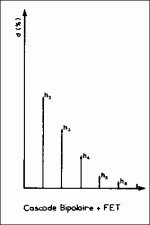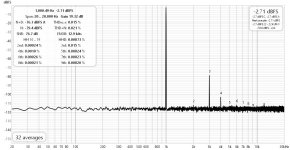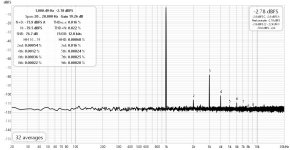This is what the distortion spectrum looks like when everything is well matched at operating conditions :
https://www.diyaudio.com/community/threads/hiraga-le-monstre-2024.413301/post-7698384
20dB lower even harmonics.
Patrick
https://www.diyaudio.com/community/threads/hiraga-le-monstre-2024.413301/post-7698384
20dB lower even harmonics.
Patrick
I simply wanted to remind you that in France audiophiles highlighted the search for a linear harmonic distortion where H2 was greater than H3.
I'm not good enough with electronics to offer a solution. 😕
I'm not good enough with electronics to offer a solution. 😕
in France audiophiles highlighted the search for a linear harmonic distortion where H2 was greater than H3.
Then one should be building single ended circuits and not push-pull or balanced.
The latter cancels even harmonics by design, to a greater or less extent.
Patrick
Yes, it's likely!Post #119:
I think the figure refer to the collector of the cascode transistor, not the amplifier output.
It may well be that a little rest for the ear and brain will differentiate and contrast the differences more clearly. And also longer listening phases: calmly listen to one amp for 30 minutes, or 1 hour, and then the other.Myself and three seasoned audiophile friends spent most of today listening to two versions of the Le Monstre. The first of these was as close as possible to the original (with the exception of the 2SK170Y/2SJ74Y which are truly unobtainium) powered from two car batteries via 160,000uF per channel. The second is a modern version with all currently available components, and this was powered via a Didden super regulator adjusted for high current supplied from a lab bench supply. Both amps were fed through a mosfet based A-B switching device to allow switching of the amps on the fly. The source was AD1862 DAC through an 01A preamp and the speakers were stacked quad 57 ESLs. Each person got to sit in the hot chair for extended periods, listening to music they were more or less familiar with, and could switch between amps via a remote control for the A-B switch. As we listened, we made sure to play a wide variety of music to cover all bases and tastes.
Overall the amp sounds really good - great bass attack, smooth vocals and highs, it really has a nice sound - and you have to bear in mind these little ~7-8W amps were driving stacked ESL57s, hardly the kindest of loads. However, it was clear from the start that there were only very minor differences between the two amps. In general, comments from all listeners were consistent - there was a slight difference in sound between both amps, and this was almost imperceptible with some tracks, and more noticeable with others. The original version had a slightly narrower soundstage (left to right) but also sounded just a little softer, most noticeable on vocals which had a harder edge. By comparison the modern version was just a little more defined, and had tighter bass. It sounds from this that these were clearly heard distinctions - they absolutely were not. The differences were tiny, and I think if the A-B switch was not in place we would never have been able to tell the difference. Each of us were really searching for differences as tracks played - not the normal way anyone would listen to music and I think its really important to emphasise how small the differences were.
A third version of this amp is similar to the original which is now known as the Le Monstre Deluxe, is fitted with passives close to those recommended by Jean Hiraga - tantalum resistors and wire wound pots. We did not have time today to compare this deluxe build with the originals - this will be done in a future session. For now, I am clear that there is almost no difference in these first two versions, despite the vastly different power supplies, and I think avoiding the use of large, heavy and awkward car batteries is a no-brainer. A part of me wants to listen to the original version with the same power supply as the modern version to see if those differences disappear completely
As announced, I took out my Le Monstre and plugged it in.
I replaced the output pair TIP3055/TIP2955 in TO-247 housings (#78) with a pair of BD441/BD442 in TO-126 housings. Quick and provisional. These are also some of the best power transistors in terms of sound, and completely sufficient for a Le Monstre with 12 watts/transistor. What can I say: finally a black, shiny, clear, focused, clear cut contours in 3D stage, and finally voices are understandable and the bass has power and blackness and punch; very musical, a unified orchestra. The big ones can't keep up: just a tempo-less, sluggish, colorless, contourless image. I have also run the small ones at 2 x 18 volts, but I didn't like the sound any better. The small trannies can also cope with this power.
I installed TO-220 power resistors. These also sound much cleaner than any wire on sand in cement type. But smaller TO-126s would go one step further in terms of cleanliness and clarity.
In my Monstre, the 2nd and 3rd stages of the circuit run with identical complementary transistors. Here BC550/BC560. The advantage is that the sound is not modulated by 2 x 4, i.e. 8 different parts, i.e. 8 sound characters, but only 2 x 3. This may benefit the homogeneity.
I must finally get a pair of SK170/SJ74. I haven't checked their sound yet.
Superb half-wave balanced PP amplifier that is a lot of fun and would please many people straight away with its joy of playing and power. Focused and concentrated on the essentials. A real party machine;-)
No unnecessary eyelets and solder pins. Copper plates and other things are untested nonsense, no bridges or streetcar tracks are earthed here.
A pcb is not necessary for this small setup, which also has advantages in terms of sound.
The sound can be tuned considerably with the power supply unit and its components. But I don't want to give tips here.
I can only give these tips. But I can't do it for you and hear it for you.
... your other, second 2024 Hiraga Le Monstre;-)
I replaced the output pair TIP3055/TIP2955 in TO-247 housings (#78) with a pair of BD441/BD442 in TO-126 housings. Quick and provisional. These are also some of the best power transistors in terms of sound, and completely sufficient for a Le Monstre with 12 watts/transistor. What can I say: finally a black, shiny, clear, focused, clear cut contours in 3D stage, and finally voices are understandable and the bass has power and blackness and punch; very musical, a unified orchestra. The big ones can't keep up: just a tempo-less, sluggish, colorless, contourless image. I have also run the small ones at 2 x 18 volts, but I didn't like the sound any better. The small trannies can also cope with this power.
I installed TO-220 power resistors. These also sound much cleaner than any wire on sand in cement type. But smaller TO-126s would go one step further in terms of cleanliness and clarity.
In my Monstre, the 2nd and 3rd stages of the circuit run with identical complementary transistors. Here BC550/BC560. The advantage is that the sound is not modulated by 2 x 4, i.e. 8 different parts, i.e. 8 sound characters, but only 2 x 3. This may benefit the homogeneity.
I must finally get a pair of SK170/SJ74. I haven't checked their sound yet.
Superb half-wave balanced PP amplifier that is a lot of fun and would please many people straight away with its joy of playing and power. Focused and concentrated on the essentials. A real party machine;-)
No unnecessary eyelets and solder pins. Copper plates and other things are untested nonsense, no bridges or streetcar tracks are earthed here.
A pcb is not necessary for this small setup, which also has advantages in terms of sound.
The sound can be tuned considerably with the power supply unit and its components. But I don't want to give tips here.
I can only give these tips. But I can't do it for you and hear it for you.
... your other, second 2024 Hiraga Le Monstre;-)
Attachments
This is all very well, but this report has no place here: very far from the original 'Le Monstre' amplifier. 🙄
The aim of Jean Hiraga was not, is not, good sound;-?
I'll get the 170/74 sometime and see if they sound any better than the 246/103, for example.
If you use accus, test them without capacitors.
😉
I'll get the 170/74 sometime and see if they sound any better than the 246/103, for example.
If you use accus, test them without capacitors.
😉
Also - pretty much there will never be another exact Le Monstre anyway as the 2sk170y/2sj74y are really unobtainium now. So we need to use as close as we can or use the original as a jumping off point to work on a different version using modern components.
There is next to no difference between Y grade and GR grade + current source bypass.
And you can still get TaN resistors, if you must.
So you can still build very close to the original.
The question is whether you can hear enough difference to justify the premium.
That you have to decide for yourself.
🤓
Patrick
And you can still get TaN resistors, if you must.
So you can still build very close to the original.
The question is whether you can hear enough difference to justify the premium.
That you have to decide for yourself.
🤓
Patrick
Patrick's post aims to make a HIRAGA "Le Monstre" amplifier as close as possible to the original. It might therefore be appropriate to open another post given that the version you are proposing does not include any of the transistors of Jean HIRAGA's realization. In addition, it will not be able to be compared to any other by the panel of listeners present here, so why come and clutter his approach?The aim of Jean Hiraga was not, is not, good sound;-?
I'll get the 170/74 sometime and see if they sound any better than the 246/103, for example.
If you use accus, test them without capacitors.
😉
You are perfectly free to open a post where everyone can present their interpretation of this amp.
Can you please give more adjectives to describe the scratchiness? I'm sorry but I don't understand. It lacked smoothness? Any theories why? Would putting caps in between resolve the scratchiness, but keep most of the benefits? Is this lead acid battery? How about LI ion?For example, I used a small SE with only one battery, without any capacitors: The bass was deep black, funky and contoured, the colors consistently clear and rich, speed and clarity far above mains, but the treble was scratchy. But I quickly got used to it;-)
I would definitely try the Le Monstre only with batteries
Better not mounting the Sziklai parts together on the same heat sink, that can invoke a thermal runoff.A pcb is not necessary for this small setup
Have the drivers hanging on the leads and with separate small (U-shaped) heat sinks.
At the time of the original publication by Jean Hiraga, there was no Lithium Ion batteries.How about LI ion?
🙂
Patrick
Because we want to be sure, we went back to remeasure both channels of the Le Monstre Deluxe again.
Not only are the measurements repeatable, but both channels are very closely matched.
And very low even harmonics. 🙂
Patrick
.
Not only are the measurements repeatable, but both channels are very closely matched.
And very low even harmonics. 🙂
Patrick
.
Attachments
#9: https://www.diyaudio.com/community/...sk170-jfet-pairs-grade-b.321649/#post-5414854The aim of Jean Hiraga was not, is not, good sound;-?
I'll get the 170/74 sometime and see if they sound any better than the 246/103, for example.
If you use accus, test them without capacitors.
😉
I ordered two pairs of Toshiba 170/74 with reference from Nelson. If these little things don't get lost on the road, I'll tell you - hopefully soon - how they sound;-)
Right!Section 4, thermal stability.
My intuitive assumption prooved wrong.
To all: read it!
Thanks EUVL!!!
- Home
- Amplifiers
- Solid State
- Hiraga Le Monstre 2024

![DSCN0501[1].JPG](/community/data/attachments/1247/1247457-da3fd2b83239c6761448049aaaacf472.jpg?hash=2j_SuDI5xn)
![DSCN0502[1].JPG](/community/data/attachments/1247/1247458-1ef8918505d79be2bfb5d128b5e7ac8d.jpg?hash=HviRhQXXm-)

